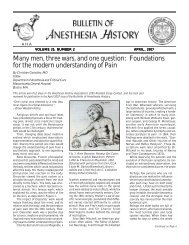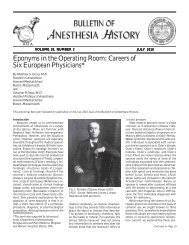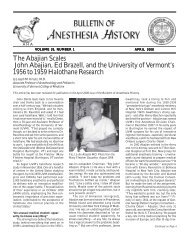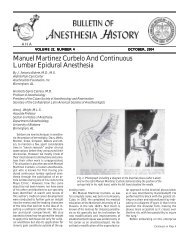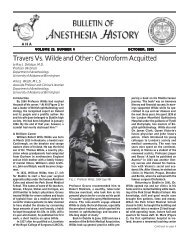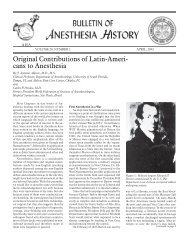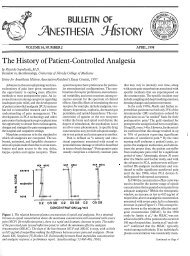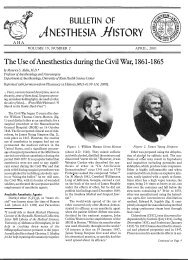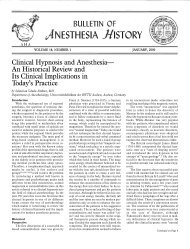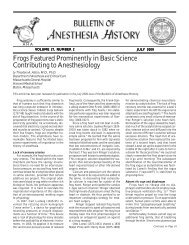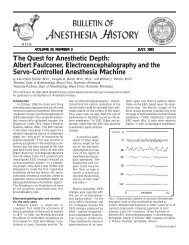January 2006, Vol 24 - Anesthesia History Association
January 2006, Vol 24 - Anesthesia History Association
January 2006, Vol 24 - Anesthesia History Association
Create successful ePaper yourself
Turn your PDF publications into a flip-book with our unique Google optimized e-Paper software.
Quistorp and “Anaesthesia” in 1718*<br />
by Ray J. Defalque, M.D.<br />
Professor {Retired}<br />
Department of Anesthesiology<br />
University of Alabama at Birmingham<br />
Amos J. Wright, M.L.S.<br />
Associate Professor and Clinical Librarian<br />
Department of Anesthesiology<br />
University of Alabama at Birmingham<br />
BULLETIN OF ANESTHESIA HISTORY 5<br />
Introduction<br />
On July 20, 1718, Johann Bernhard<br />
Quistorp (1692-1761) appeared in the<br />
great auditorium at the University of<br />
Rostock, in what is now eastern Germany,<br />
to submit to a public examination of his<br />
doctoral thesis, (Disputatio inauguralis<br />
medica) De Anaesthesia, or, “Anaesthesia, a<br />
state of insensitivity.” This document is<br />
dedicated to the university’s anatomy and<br />
botany professor and dean, Dr. George<br />
Detharding (1671-1747), who taught there<br />
for some 35 years. 1 Detharding was a prolific<br />
author on medical and other topics;<br />
the U.S. National Library of Medicine owns<br />
several dozen of his works.<br />
Written in the customary Latin,<br />
Quistorp’s dissertation was printed by J.<br />
Wepping, “Printers of the Court and<br />
University,”as the title page announces, in<br />
that same year. The full document was<br />
translated into English for the first time<br />
in 1999 by Ray J. Defalque. Original copies<br />
are rare. According to OCLC’s<br />
WorldCat database, which includes the<br />
holdings of most major and many minor<br />
libraries in the United States and some<br />
elsewhere, the only copy in the United<br />
States is held by the National Library of<br />
Medicine’s <strong>History</strong> of Medicine Division.<br />
That copy has been microfilmed and can<br />
be borrowed in that format via interlibrary<br />
loan. Our departmental library has a photocopy,<br />
as does the Wood Library-Museum<br />
of Anesthesiology.<br />
Quistorp was born in Rostock in August,<br />
1692, the son of pharmacist Bernhard<br />
Balthasar Quistorp and Mary Elizabeth<br />
Kruck, the daughter of a prominent local<br />
merchant. Quistorp’s father provided him<br />
with a good education, first with private<br />
tutors and then at the Gymnasium at<br />
Gustrow. He entered the University of<br />
Rostock, which was founded in 1419 and<br />
is the oldest university in northern Europe.<br />
There Quistorp studied for five years<br />
under Detharding, completing a 75-page<br />
*This is the Introduction to the Quistorp article.<br />
If you would like to read the entire article,<br />
please contact the authors.<br />
thesis on the effects of purgatives,<br />
Scrutinium operationis medicamentorum, nominatim<br />
vomitoriorum, purgantium…, which was<br />
printed in Rostock in 1713. Then he spent<br />
two years at the University of Leipzig medical<br />
school, where he studied therapy under<br />
Johann Bohn (1640-1718), pathology under<br />
Augustus Quirinus Rivinus (1652-<br />
1723), materia medica under Ermullern<br />
[whom we have yet to identify], and surgery<br />
and anatomy under Johann Wilhelm<br />
Pauli (1658-1723). After Leipzig, Quistorp<br />
traveled to other cities such as Vienna,<br />
Prague, Munich, and Hamburg to meet and<br />
learn from the prominent physicians there.<br />
On July 19, 1718, he received the title of<br />
physician and defended his dissertation<br />
the following day. By this time Quistorp’s<br />
medical education and experience were extensive,<br />
and he established a practice in<br />
Rostock.<br />
In 1742 Quistorp was named city physician<br />
by the town magistrates. On July 25<br />
of the following year, he began a teaching<br />
career much delayed by his busy practice.<br />
His inaugural lecture was devoted to “De<br />
curatione corporis morali “ (on the moral<br />
cure of the body). Over the years Quistorp<br />
delivered several Easter, Christmas, funeral<br />
and other public orations. At least<br />
one of his religious orations, Gloriosissimum<br />
resurrections Jesu Christi festum…, was<br />
printed in Rostock in 1751. One of his funeral<br />
speeches, in 1745, was entitled “Anaesthesia,”<br />
no doubt based on his 1718 dissertation.<br />
Other topics were also religious<br />
in nature; two praised Prince Carl Leopold,<br />
Archduke of Mecklenburg. In 1752<br />
Quistorp published a discourse, De<br />
Acidorum indole et effectibus (on the nature<br />
and action of acids). Quistorp died on December<br />
8, 1761. 2 Nothing is yet known about<br />
Quistorp’s family, assuming he had one.<br />
There was a Johann Christian von<br />
Quistorp who published several titles in<br />
Rostock between 1778 and 1793. A Johann<br />
Jacob Quistorp [1717-1766] also published<br />
several items in that city in the 1750s.<br />
The earliest appearances of the word<br />
“anaesthesia” in modern western literature<br />
prior to Quistorp and known to us are in<br />
Phillips, The New World of Words: or, Universal<br />
English Dictionary (6 th . Ed., 1706), and<br />
Castelli’s Lexicon Medicum Graeco Latinum<br />
(1713), where it is defined as a “privation<br />
of the senses.” Yet the word with this and<br />
other definitions was used widely by ancient<br />
Greek and Latin authors, and was<br />
apparently coined between the 10th and<br />
5th centuries BC. 3 Among the authors who<br />
used the word to denote deprivation of the<br />
senses or insensitivity to pain are<br />
Linnaeus, Epicurus, Hippocrates,<br />
Hippon, and Demosthenes. Isocrates,<br />
Demosthenes and others also used the<br />
word to mean either stupidity or irresponsibility.<br />
Plato, who used the term 18 times,<br />
implied both meanings. In Timaeus, Plato<br />
used the word several times to indicate a<br />
condition where an impulse does not reach<br />
the brain.<br />
Galen, a Greek physician from Asia<br />
Minor born in 141 AD, used the word to<br />
describe “the dullness of those who think<br />
differently.” 3 In his Ethics, Aristotle defines<br />
it as the opposite of “debauchery and<br />
prudence.” 4 Dioscorides Pedanius, a first<br />
century AD military physician under the<br />
Roman emperors Claudius and Nero, used<br />
the word to describe a mixture of wine and<br />
mandrake root extract useful for insomnia,<br />
chronic pain, and “during cutting and<br />
cautery.” 5 Dioscorides’ De Materia Medica,<br />
in which this description appeared, remained<br />
in use well into the Renaissance,<br />
as did the works of Galen. Their influence<br />
in medical practice over so many centuries<br />
may account for the survival of the rather<br />
obscure word “anesthesia” and its association<br />
with a state of pain deprivation.<br />
Between Quistorp and Oliver Wendall<br />
Holmes’ suggestion of the term to William<br />
Morton in a famous letter dated November<br />
21, 1846, the word appears in several English-language<br />
dictionaries and some other<br />
medical works and generally is defined to<br />
mean a loss of the sense of touch. Holmes<br />
acknowledged this definition and his<br />
sources as “…more particularly (as used<br />
Continued on page 6



